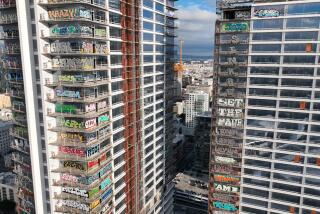Naval Property Conversion Could Do Much for Residents
- Share via
In response to your article Dec. 15 on replacing the “lost Disney resort”:
First, we don’t need a quick fix. We knew that Disneyland wasn’t built in a day. We did hope, however, that they would be the “Rescuers Down Under.” If anyone could transform 250 acres of submerged oceanfront property into profit, they could.
Tourism and entertainment are tempting. A cruise dock is a nice idea. But isn’t the so-called “Disney site” part of a much larger question here?
We need to develop jobs that produce non-polluting products, upgrade the local infrastructure and pay wages you can live on. The Brooklyn Naval Yard “Can Do Partnership” built, among other things, an industrial park with 45 firms from shipbuilders, importers (and) food-sale specialists to pipe fitters.
People need to be developed by increasing their skills for 21st-Century markets (more retraining programs, more transition support groups for people moving from one walk of life to another, and more income-relief programs for ex-McDonnell Douglas employees).
Low-income housing is needed. (Is there any possible conversion of naval housing, or the buildings on existing base, should it be made available?)
We need medical care. (A creative response should be developed to the “downsizing” of the Naval Hospital.)
How we develop is as important as what we build.
A creative democratic planning process is called for, which involves the city in partnership with aerospace and other labor groups, business, churches, social service groups (housing, human needs), legislators, and other relevant community groups to plan for a city less dependent on the Pentagon for its money. According to a Press-Telegram article April 18, we have the fourth-highest Pentagon allotment of all the cities in the United States.
Now, where are the models for this planning? All over the country! States and cities are pulling together these constituent groups to assist government in development and conversion planning. Projects are described in “Base Conversion News” and “Positive Alternatives,” both publications of the Center for Economic Conversion, 2222 View Street, Suite C, Mountain View, Calif. 94041.
The city’s recent recommendation that an internal city committee be set up to assess all aspects of the Navy property issue is a commendable one. The city needs to expand that internal committee to include an advisory group of the above-mentioned constituencies to open up the community conversion-planning process to indeed represent the community.
What should be done with the Disney site? That’s not the real question. Let’s not bury our heads in the sand . . . or DisneySea. The real question is: How can community groups join hands with the city in developing the future Long Beach, which calls for a lessening of military growth, and an increase in the development of people’s skills, the local infrastructure and products for sensible civilian use.
One answer is a city/community partnership in conversion planning.
Long Beach Area Task Force on Economic Development/Conversion
Dr. Nancy L. Mary, professor, Cal State San Bernardino
The Rev. Donald C. Thompson
Harold Collins, Long Beach Area Peace Network
Marion Morgan, South Coast Ecumenical Council
Jo Rae Zuckerman, Beyond War/Foundation for Global Community
Lindsey Mattingly, Teachers Assn. of Long Beach and Wrigley Assn.
Pat Troy, Operating Engineers Union Local No. 12
More to Read
Inside the business of entertainment
The Wide Shot brings you news, analysis and insights on everything from streaming wars to production — and what it all means for the future.
You may occasionally receive promotional content from the Los Angeles Times.










